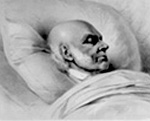The Lindy Claiborne Boggs Room
Cite this Page
Office of History and Preservation, Office of the Clerk, http://clerk.house.gov/art_history/art_artifacts/boggs-reading-room/history.html, (December 03, 2010).
For Additional Information
Office of History and Preservation
(202) 226-1300
history@mail.house.gov
Early History
The historical importance of the Lindy Boggs room begins with its origins. There are no records indicating that this space was rebuilt after the fire of 1814, which makes it probable that this space is one of the few rooms that survived the conflagration without major damage.
The main room has an unusual shape, designed in the Classical Revival style favored by its architect, Benjamin Henry Latrobe. The ceiling is composed of three types of vaults—two half-barrels, a groin vault at the center, and a curved apse end. Built from masonry, vaults were both stylistically attractive and important for fire-proofing—potentially a factor in the room’s survival. The original décor was simple, including a brick floor and whitewashed walls with painted woodwork. The ceiling was painted with eagle heads, shields, and other decorative motifs around the turn of the twentieth century. The chandelier, added around 1915, was purchased from Brook Brothers of Washington.
Prior to its becoming the Women’s Reading Room, the Clerk of the House resided here, beginning in 1857. Through the years, the Clerk was joined by the Committee on Banking and Currency (1874–1885) and the Enrolling Clerk (1915–1918) in what is now the Lindy Boggs suite.
Speaker’s Rooms
After Statuary Hall was remodeled as a result of the fire of 1814, this space became the Speaker’s Office. Henry Clay was its first occupant, using the room from 1819 to 1821 and from 1823 to 1825. Clay had a long and illustrious career, serving in both the House and the Senate. He was elected Speaker on his first day in the House in 1811 and went on to transform the speakership into a powerful leadership post. During his first term, he led the “war hawk” faction that pushed the country into conflict with Great Britain in the War of 1812—though he later resigned from the House to serve as a U.S. commissioner to negotiate the Treaty of Ghent, which ended the war. After reclaiming the speakership, Clay was instrumental in steering the Missouri Compromise of 1820 to passage.
John Quincy Adams
One of the most significant events that took place in this room occurred during Robert Winthrop’s speakership. On February 21, 1848, John Quincy Adams suffered a stroke in the adjoining Chamber. “Old Man Eloquent” was carried to the Speaker’s Office, now the Lindy Claiborne Boggs Congressional Women’s Reading Room, where he died two days later. Adams, the nation’s sixth President, served in the House for 16 years after he lost his presidential reelection bid to Andrew Jackson in 1831. He considered his time as a Representative the happiest of his fifty years of public service.
In 1991, while reflecting upon the significance of Adams’s death in this room, Lindy Boggs recalled that Adams’s formidable mother, Abigail, had written to her husband as the Declaration of Independence was being drafted, instructing him to: “Remember the Ladies and be more generous and favorable to them than your ancestors.”
Concerning the rumors about Adams’s ghost haunting the suite, Boggs said:
“… poor John Quincy. He’s suffering from the errors of his father … but I think Abigail’s wishes are now being carried out. Her son will forever be surrounded by strong ladies.”

The Lindy Claiborne Boggs Room

John Quincy Adams on his Deathbed, lithograph, after Arthur J. Stansbury,1848 Image courtesy of the Library of Congress

Henry Clay, oil on canvas, Giuseppe Fagnani, 1852
Collection of the U.S. House of Representatives


